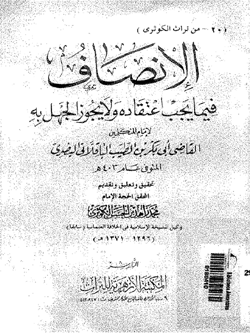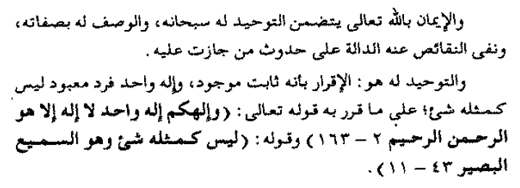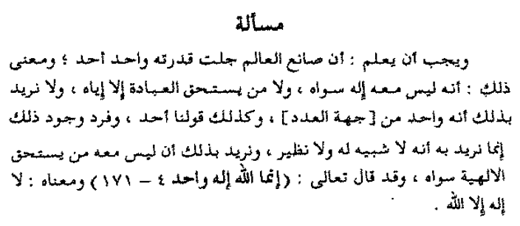Asharis.Com
Posted by Abu.Iyaad on Saturday, April, 03 2010 and filed under Articles
Key topics: Al-Baqillani • Abu Bakr Al-Baqillani • Tawhid • Tawhid Al-Uloohiyyah • Tawhid Al-Ibaadah

Background Information
We have established in the articles on this website with sufficient proof that what is known today as the Ash'ari madhhab is in fact a hybrid of the doctrines of the Jahmiyyah, Mu'tazilah and the Kullaabiyyah, and historically, what was known as the Ash'ari madhhab, was simply a relabeling and popularization of the Kullaabi creed with the label of "Ash'ariyyah", through Abu al-Hasan al-Ash'ari, after his abandonment of the creed of the Mu'tazilah. However, the Later Ash'aris began hybridizing this original creed, due to their inability to satisfactorily resolve issues raised against aspects of their creed.
The origins of all of these deviant creeds lie in an intellectual proof called "hudooth ul-ajsaam" on account of which the Jahmiyyah denied all names, descriptions, attributes and actions for Allaah, and the Mu'tazilah affirmed the names on the surface, and denied the attributes and actions, and the Kullaabiyyah were the first of the Mutakallimeen to affirm something of the attributes, whilst denying the actions of Allaah (being tied to His will and power). This became the hallmark of the Kullaabi doctrine, namely rejection of those attributes tied to Allaah's will and power (al-istiwaa, an-nuzool, al-mahabbah, al-ghadab and so on), upon the argument that they would necessitate that Allaah is a jism (body), being subject to accidents, incidental attributes (a'raad, hawaadith). Alongside this, they affirmed the sifaat dhaatiyyah (attributes of the essence), such as Face, Hands, Eyes, and also affirmed Allaah being above His creation, above the Throne, with His Essence. This was the Kullaabi doctrine that took on the name of "Ash'ariyyah".
Since this creed of the Mutakallimeen in general (Jahmiyyah, Mu'tazilah, Kullaabiyyah, Ash'ariyyah, Maturidiyyah), as it relates to Tawhid, is centered only around establishing the existence of a creator - then as knowledge waned over the centuries, and ignorance set in, it was amongst these very people that deviation in the very core of Tawhid emerged. This occurred in the 7th and 8th centuries (after the hijrah). As for the earlier Scholars amongst the Ash'aris then despite their deviation in aspects of the creed (names and attributes, al-qadar, al-eemaan and so on), they were clear on the very foundations of Tawhid, meaning that which the Messengers came to establish, which was Tawhid al-Uluhiyyah, or Tawhid al-Ibaadah.
In this article we will establish this, from the most important figure in the actual formalization of the Ash'ari madhhab, al-Qaadi Abu Bakr al-Baqillani (d. 403H).
Al-Qadi Abu Bakr al-Baqillaani on Tawhid, and in Particular Tawhid al-Ibaadah, Tawhid al-Uluhiyyah
 Al-Baqillani is the one who can be credited with formalizing the As'hari madhhab through his works, in particular at-Tamheed and also al-Insaaaf. What he laid down in these books became the foundations of "Ash'ariyyah". As we stated earlier, these Early Ash'aris had a grounding in the understanding and presentation of Tawhid which the Later Ash'aris did not maintain (in the 7th, 8th centuries). Today's hybridized Jahmiyyah-Mu'tazilah-Kullaabiyyah posing as Ash'aris and taking on the banner of "Ash'ariyyah" attack the classical understanding of Tawhid, which is that Tawhid is to single out Allah in his right of worship (ibaadah), after singling Him out in his Lordship (ruboobiyyah), the former, being an inevitable consequence of the latter, with this being the Qur'anic reasoning against the calling upon others besides or alongside Allaah. Today's Ash'aris scorn the classification of Tawhid in this manner (Ruboobiyyah, Uloohiyyah and al-Asmaa was-Sifaat), claiming it is an innovation of the later times.
Al-Baqillani is the one who can be credited with formalizing the As'hari madhhab through his works, in particular at-Tamheed and also al-Insaaaf. What he laid down in these books became the foundations of "Ash'ariyyah". As we stated earlier, these Early Ash'aris had a grounding in the understanding and presentation of Tawhid which the Later Ash'aris did not maintain (in the 7th, 8th centuries). Today's hybridized Jahmiyyah-Mu'tazilah-Kullaabiyyah posing as Ash'aris and taking on the banner of "Ash'ariyyah" attack the classical understanding of Tawhid, which is that Tawhid is to single out Allah in his right of worship (ibaadah), after singling Him out in his Lordship (ruboobiyyah), the former, being an inevitable consequence of the latter, with this being the Qur'anic reasoning against the calling upon others besides or alongside Allaah. Today's Ash'aris scorn the classification of Tawhid in this manner (Ruboobiyyah, Uloohiyyah and al-Asmaa was-Sifaat), claiming it is an innovation of the later times.
Al-Baqillani writes in al-Insaf (p. 22)

And faith (al-eemaan) in Allaah, the Exalted comprises making Tawhid for Him, the Sublime (i.e. singling Him out), and describing Him with His Attributes, and negating shortcomings from Him which [otherwise] indicate the createdness of the one upon whom these shortcomings are permissible.
And "making Tawhid for Him" is: Affirming that He is established, existing, and one ilaah (deity), single, worshipped (ma'bood), there being no likeness unto Him, upon what is established by His saying, the Exalted, "And your ilaah (deity) is a single (deity), there is none which has the right to be worshipped except He, the One full of mercy, Merciful (to His servants)" (Baqarah 2:163), and His saying, "There is no likeness unto Him, and He is all-Hearing, all-Seeing" (ash-Shura 42:11).
And he writes (p. 32)

Issue: And it is obligatory to know that the creator of the universe, lofty is His power, is one (waahid) unique (ahad). And the meaning of that is: That there is not with Him an ilaah besides Him, and nor anyone who has the right of worship, except Him alone. And we do not mean by that, that He is "one" (waahid) from the angle of number, and likewise [we do not mean the aforementioned through] our saying "unique" (ahad), and existing, singular. Rather, we intend by it that there is nothing resembling [Him] (shabeeh) and nor any aider, supporter (dhaheer). And we intend by that, that there is none alongside Him that deserves [the right] of ilaahiyyah besides Him, and Allaah, the Exalted said, "Indeed Allaah is a single ilaah (deity)" (an-Nisa 4/171), and its meaning is "There is none which has the right to be worshipped except Allaah (alone)."
In the above two statements, al-Baqillani, has explained Tawhid in a manner in which it is essentially summarized and brought together in accordance with three categories of Tawhid, which are Tawhid ar-Ruboobiyyah, Tawhid al-Ibaadah and Tawhid al-Asmaa was-Sifaat, and he has through this explanation, silenced the later ones who waged a war against such a presentation of the Tawhid of the Messengers. So it's worthy we comment on it piecemeal.
Al-Baqillani's Corroboration of the Tawhid of the Messengers
He said:
And faith (al-eemaan) in Allaah, the Exalted comprises making Tawhid for Him, the Sublime (i.e. singling Him out), and describing Him with His Attributes, and negating shortcomings from Him which [otherwise] indicate the "Hudooth" (createdness) of the one upon whom these shortcomings are permissible.
In light of the sum of the two statements above, what al-Baqillani means by "making Tawhid for Him", is a) singling Him out in worship, and b) singling Him out in His attributes and c) negating such descriptions from Him that would necessitate "Hudooth". And this third part here is simply the Kullaabi doctrine of negating attributes for Allaah which are tied to His will and power (i.e. His actions) - and this is what the Ash'aris consider to be from Tawhid, meaning to negate that He makes istiwaa (as an action) and Nuzool (as an action) and that He displays love, anger, pleasure (as actions) - this is what al-Baqillani means, because upon the Kullaabi doctrine, affirming these attributes are incompatible with the intellectual proof used to prove Allaah's existence ("hudooth ul-ajsaam") - remember they were upon that same intellectual proof pioneered by the Jahmiyyah (Jahm bin Safwaan) and the Mu'tazilah (Abu al-Hudhayl al-Allaaf) - so they deny what they refer to as "hawaadith" (events, occurrences) and this was unknown to the Salaf and their Imaams, for they affirmed Allaah's Names, Attributes and Actions, and their books are replete and full of that in refutation of the Jahmiyyah and Mu'tazilah.
So this is what he means when he says:
...and negating shortcomings from Him which [otherwise] indicate the createdness of the one upon whom these shortcomings are permissible.
He then explains what he means by "Tawhid":
And "making Tawhid for Him" is: Affirming that He is established, existing, and one ilaah (deity), single, worshipped (ma'bood), there being no likeness unto Him, upon what is established by His saying, the Exalted, "And your ilaah (deity) is a single (deity), there is none which has the right to be worshipped except He, the One full of mercy, Merciful (to His servants)" (Baqarah 2:163), and His saying, "There is no likeness unto Him, and He is all-Hearing, all-Seeing" (ash-Shura 42:11).
So here he has essentially affirmed Tawhid ar-Ruboobiyyah (affirmation of His Existence) and Tawhid al-Ibaadah, (a single deity, worshipped), and there being no likeness unto Him, this being Tawhid al-Asmaa was-Sifaat, along with what he already stated earlier that from Tawhid is to describe Him with His attributes.
Then in the second statement, it is more clear, and we see it very explicitly here:
Issue: And it is obligatory to know that the creator of the universe, lofty is His power, is one (waahid) unique (ahad) ...
So after affirming the creator of the universe (Tawhid ar-Ruboobiyyah) being one, unique, he goes on to explain precisely what he means:
And the meaning of that is: That there is not with Him an ilaah besides Him, and nor anyone who has the right of worship, except Him alone...
So here you should pay attention to his saying, ( ليس معه إله سواه), and his saying, (ولا من يستحق العبادة إلا إياه), so this is Tawhid al-Ibaadah, and it constitutes a silencing of those who claim that "Tawhid al-Ibaadah" is an innovation of Ibn Taymiyyah or Ibn Abdul-Wahhaab.
Then he goes on to explain what he does not mean:
And we do not mean by that, that He is "one" (waahid) from the angle of number, and likewise [we do not mean the aforementioned through] our saying "unique" (ahad), and existing, singular.
So this only confirms and emphasizes that he actually means singling out Allaah in His right to be worshipped, because he has clarified here that by using the words "waahid" (one), and "ahad" (unique) and "fard" (singular) that he does not mean singularity, or uniqueness in number. Then he states one more what he does mean:
Rather, we intend by it that there is nothing resembling [Him] (shabeeh) and nor any aider, supporter (dhaheer). And we intend by that, that there is none alongside Him that deserves [the right] of ilaahiyyah besides Him...
So here speaks with what amounts to Tawhid al-Asmaa was-Sifaat, and Tawhid al-Uloohiyyah, and he explains this to be the meaning embodied in the saying of Allaah, and the actual kalimah itself
...and Allaah, the Exalted said, "Indeed Allaah is a single ilaah (deity)" (an-Nisa 4/171), and its meaning is "There is none which has the right to be worshipped except Allaah (alone)."
So there you have it, al-Baqillani, has spoken with the classic understanding of Tawhid which consists of Tawhid ar-Ruboobiyyah, Tawhid al-Ibaadah, and Tawhid al-Asmaa was-Sifaat, and even though he has not expressly used these terms, in his explanation, the whole of Tawhid is comprised in the meanings that these three terms represent, which al-Baqillani has used to express what faith in Allaah means and requires.
The Meaning of the Kalimah
It is worthy to single out attention to the statements of al-Baqillani, in explanation of Tawhid:
...there is not with Him an ilaah besides Him, and nor anyone who has the right of worship, except Him alone
... there is none alongside Him that deserves [the right] of ilaahiyyah besides Him.
And this is how the kalimah has been explained by the Ulamaa' of Tawheed, and this is the Tawhid of the Messengers, and this is unlike the classification given by those Ash'arites who came later such as ash-Shahrastani and others who explain Tawhid as:
Allaah, the Exalted is one (waahid) in His Essence, He has no divisibility (therein), and one (waahid) in his eternal Attributes, there is no equal to Him therein, and one (waahid) in His actions, there is not partner to Him therein.
And this explanation does not go beyond Tawhid ar-Ruboobiyyah and the affirmation that He has attributes. And this is what the later Ash'arites remained upon till this day of ours. With the infusion of Gnostic Sufism into the Ash'ari madhhab a few centuries after al-Baqillani (d. 403H), coupled with this deficient understanding of Tawhid, the way was paved for directing worship to others besides Allaah.
As for those who presented the classification of Tawheed upon affirmation of ar-Ruboobiyyah, al-Uloohiyyah and al-Asmaa was-Sifaat, then they include Ibn Hibbaan al-Bustee (d. 354H), Ibn Battah al-Ukbaree (d. 387H), Ibn Mandah (d. 395H) and Ibn Waleed at-Turtooshi (d. 520H), and they all precede Shaykh ul-Islam Ibn Taymiyyah and Shaykh ul-Islaam Muhammad Ibn Abdul-Wahhaab by centuries.